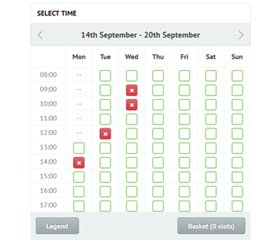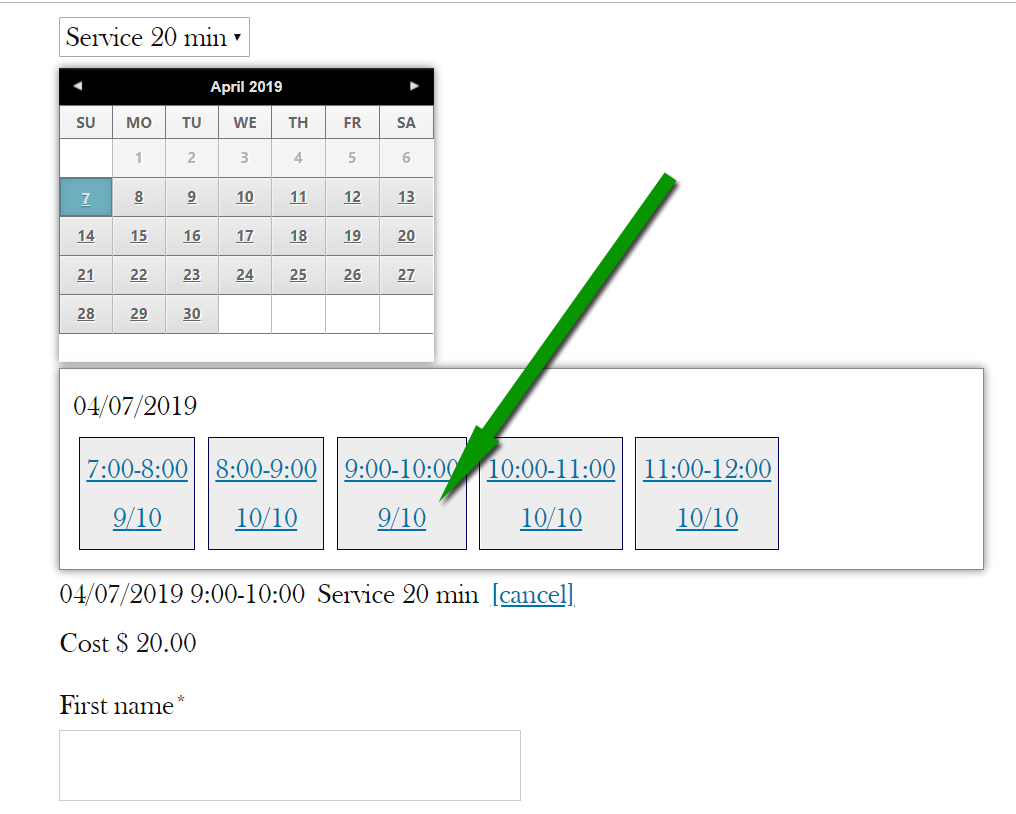Dropped Due To Slot Reservation Css
Well organized and easy to understand Web building tutorials with lots of examples of how to use HTML, CSS, JavaScript, SQL, PHP, Python, Bootstrap, Java and XML. W slot width α thermal diffusivity αS Total slot area percentage of total external surface area of liner ΔP pressure drop due to slot ΔSo oil saturation change reservoir porosity 1 cumulative oil production 5 the total steam injected? 5 1 4 cumulative steam-to-oil ratio as defined in Eq. (7) Δ temperature rise in the reservoir 1. The number of information slots to skip is known to every station, and is equal to the number of slots reserved by the upstream stations. Station I packet at 3 transmitted new transmission from. I Reservation slot Communicati - slots rame.3 frame'5 J RAF of datistation RAF,of voice station.j Figure 1 (a) Reservation and packet transmission. 21:46 Re: dropped due to slot reservation # 9 I dont think so without hreserved slots which has a feature to hold the 2 hidden slots for admins but once they have the 2 hidden slots full I think no one else can join but people usually leave before which opens up another hidden slot.
- Dropped Due To Slot Reservation Css Server
- Dropped Due To Slot Reservation Css W3schools
- Dropped Due To Slot Reservation Css File
- Dropped Due To Slot Reservation Css Free
This article will provide a brief tutorial in using HTML, CSS, JavaScript, PHP, and MySQL to build a simple reservation system. It is assumed you are already at least a little familiar with all these technologies, and the real purpose here is just to link them all together to accomplish a common task. It is intentionally over-simplified, because it is aimed at beginners.
Scenario
Let’s suppose our client owns a conference center where people can book rooms for conferences and other events. The system must be able to check for duplicate bookings and warn if there is a conflict. The system is for use only by staff of the conference center. The user must be able to quickly identify availability, preferably with a single glance at the screen.
How we will do it
Because we need to be able to see what is happening at a glance, we’ll divide the screen into two columns. In the left column, we’ll use a large calendar display showing all the days for the current month and we’ll put booking references directly on the calendar so we can see which rooms are booked and when. In the right column, we’ll show more detail for the current week.
For our calendar component, we’re going to use Kevin Ilsen’s excellent Javascript Events Calendar, which despite now being almost old enough to legally buy drinks in Canada, is still one of the best and simplest event calendars you can implement.
Setting up the database

Before we can do anything interesting, we have to do the grunt work of setting up a database that we can connect to for storing and retrieving the reservation data. Fortunately this won’t take long because it is a really simple database that we need to create.
This database design is relatively straightforward. Because its purpose is to record reservations, the Reservations table is right in the center. After creating the database, go to the Staff table and add one user as follows:
This dummy user will be needed for adding at least one real employee with an Access Level of 5 to the database. We’ll get to that in a moment.
Directory structure
The diagram below shows the directory structure used in this project.
The “assets” folder contains standard website components. The “objects” folder contains PHP code that will be included in the project.
Site structure
A good website always needs a logical structure. Here’s how it looks in this project:
Page structure

Finally we have the page structure, which is how the PHP components are stacked inside the page.
leftCol and rightCol both have their own components, which can vary depending on what is to be shown.
Creating the session check module
This component is used to start or maintain an active PHP session, and also keeps the user logged in once they are logged in.
Making the connection to the database
The database connection is located in /objects/resources/connectDB.php
This simply defines the connection string, opens a connection, and then selects the RMS database as the active database. I used $userIs instead of $userID just to ensure there is no naming conflict problem later. Obviously you need to change all the settings here to your real connection string.
Creating the page header
Every HTML document needs a <head> section to define settings for the page that will be displayed. It is located in /objects/resources/pageHeader.php
Most of this is just ordinary HTML and there are 2 important sections of PHP code.
These variables are used throughout the rest of the project. They allow us to “virtually indent” all of the HTML code so that we don’t have to physically indent it. This makes debugging much faster, so it’s a good practice.
Dropped Due To Slot Reservation Css Server
Here we choose which datepicker control to use based on the setting you selected in /objects/resources/checkSession.php
Creating the nav bar
This is a simple Bootstrap nav bar found on every page except the log-in page. It is stored in /objects/resources/navbar.php
Building the page footer
Just as every page needs a header, it also needs a footer. This just closes off the document.
Building the log-in form
Shown only once per session. This form is located in /objects/resources/frmLogin.php
See how those “n” variables work now?
Building the left column
There are two variants: /objects/resources/leftCol_main.php and /objects/resources/leftCol.php. The first is only intended to be used on the main reservations page and includes a lookup form.
Every other page uses the basic version without a lookup form.
What this actually does is display the JEC calendar that was defined in pageHeader.
Building the right column
Every page has its own unique version of rightCol, but they all work in basically the same way.
Because the rightCol is very large and complex, we’ll just dissect the simplest one (rightCol_types) and you should be able to figure out how all the others work based on that.
First, the component call. In this case (as in most others) it is simply calling the database connection.
Next we start a table.
Then define a SQL query.
With that, we can populate our table. The thisRow variable is used to detect an empty dataset.
If no data was returned, then thisRow will still be 0. We need to handle that.
Now we finish up the table and add some white space under it.
Most of the time, we’ll also provide a lookup form for tables, but in this case we restrict editing functions only to users with access level above 3.
Then all that’s left to do is tidy up.
Putting it all together
Now we need to link all these different parts together so that the page functions.
Right column for adding or modifying records
The above covered displaying records in a table, but to add or modify records we need to use forms.
Final Steps
The rest of the application is very easy to understand and should not require in-depth discussion provided you understand everything that was done in the above steps.
Now to make this a working system, you need to change database connection string information in /objects/resources/connectDB.php or the program will fail. Also change the calType session variable in /objects/checks/checkSession.php to whatever is correct for your location – “us” for countries that use m-d-y format, and “eu” for other countries. You can also use “db” to use the more natural y-m-d format.

Then simply open the application by connecting to the server where you stored it, and log in as delete using password for the password.
Immediately go to the Staff page and type 1 in the REF box. Then click MODIFY and edit the details of user “Delete Me” to your own name, user name, and password. After that, the application will work as a functioning system.
Create a hoverable dropdown with CSS.
Demo: Dropdown Examples
Move the mouse over the examples below:
Basic Dropdown
Create a dropdown box that appears when the user moves the mouse over an element.
Example
.dropdown {
position: relative;
display: inline-block;
}
.dropdown-content {
display: none;
position: absolute;
background-color: #f9f9f9;
min-width: 160px;
box-shadow: 0px 8px 16px 0px rgba(0,0,0,0.2);
padding: 12px 16px;
z-index: 1;
}
.dropdown:hover .dropdown-content {
display: block;
}
</style>
<div>
<span>Mouse over me</span>
<div>
<p>Hello World!</p>
</div>
</div>
Example Explained
HTML) Use any element to open the dropdown content, e.g. a <span>, or a <button> element.
Use a container element (like <div>) to create the dropdown content and add whatever you want inside of it.
Wrap a <div> element around the elements to position the dropdown content correctly with CSS.
CSS) The .dropdown class uses position:relative, which is needed when we want the dropdown content to be placed right below the dropdown button (using position:absolute).

The .dropdown-content class holds the actual dropdown content. It is hidden by default, and will be displayed on hover (see below). Note the min-width is set to 160px. Feel free to change this. Tip: If you want the width of the dropdown content to be as wide as the dropdown button, set the width to 100% (and overflow:auto to enable scroll on small screens).
Instead of using a border, we have used the CSS box-shadow property to make the dropdown menu look like a 'card'.
The :hover selector is used to show the dropdown menu when the user moves the mouse over the dropdown button.
Dropdown Menu
Create a dropdown menu that allows the user to choose an option from a list:
This example is similar to the previous one, except that we add links inside the dropdown box and style them to fit a styled dropdown button:
Example
/* Style The Dropdown Button */
.dropbtn {
background-color: #4CAF50;
color: white;
padding: 16px;
font-size: 16px;
border: none;
cursor: pointer;
}
/* The container <div> - needed to position the dropdown content */
.dropdown {
position: relative;
display: inline-block;
}
/* Dropdown Content (Hidden by Default) */
.dropdown-content {
display: none;
position: absolute;
background-color: #f9f9f9;
min-width: 160px;
box-shadow: 0px 8px 16px 0px rgba(0,0,0,0.2);
z-index: 1;
}
/* Links inside the dropdown */
.dropdown-content a {
color: black;
padding: 12px 16px;
text-decoration: none;
display: block;
}
/* Change color of dropdown links on hover */
.dropdown-content a:hover {background-color: #f1f1f1}
/* Show the dropdown menu on hover */
.dropdown:hover .dropdown-content {
display: block;
}
/* Change the background color of the dropdown button when the dropdown content is shown */
.dropdown:hover .dropbtn {
background-color: #3e8e41;
}
</style>
<div>
<button>Dropdown</button>
<div>
<a href='#'>Link 1</a>
<a href='#'>Link 2</a>
<a href='#'>Link 3</a>
</div>
</div>
Right-aligned Dropdown Content
Dropped Due To Slot Reservation Css W3schools
If you want the dropdown menu to go from right to left, instead of left to right, add right: 0;
Example
Try it Yourself »More Examples
Dropdown Image
Dropped Due To Slot Reservation Css File
How to add an image and other content inside the dropdown box.
Hover over the image:
Try it Yourself »

Dropdown Navbar
How to add a dropdown menu inside a navigation bar.
Try it Yourself »